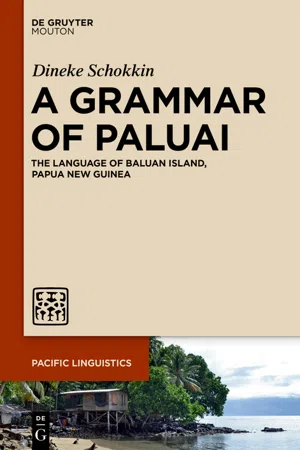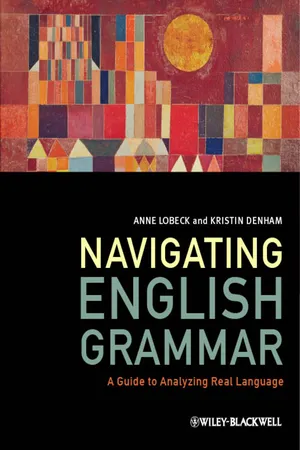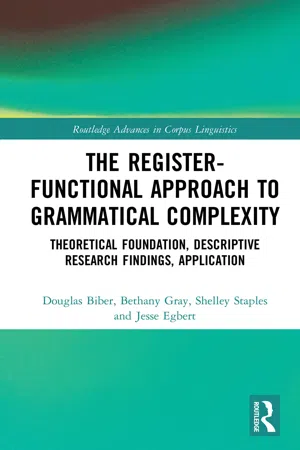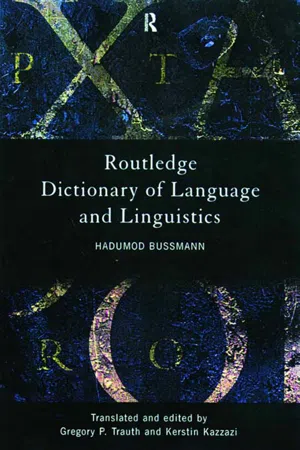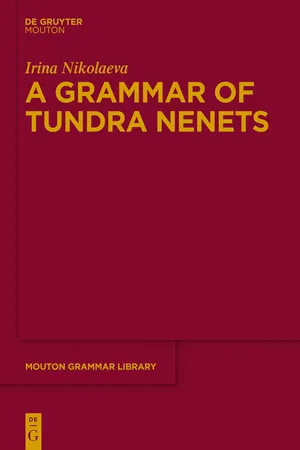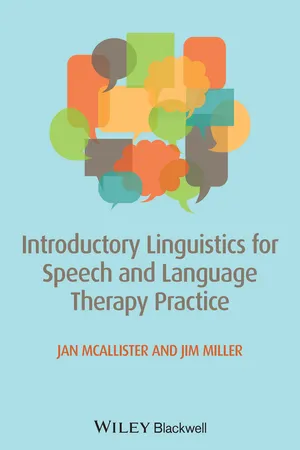Languages & Linguistics
Dependent Clause
A dependent clause is a group of words that contains a subject and a verb but does not express a complete thought. It relies on an independent clause to form a complete sentence. Dependent clauses often begin with subordinating conjunctions such as "because," "although," or "when." They add complexity and nuance to sentences by providing additional information or context.
Written by Perlego with AI-assistance
7 Key excerpts on "Dependent Clause"
Learn about this page
Index pages curate the most relevant extracts from our library of academic textbooks. They’ve been created using an in-house natural language model (NLM), each adding context and meaning to key research topics.
- eBook - ePub
A Grammar of Paluai
The Language of Baluan Island, Papua New Guinea
- Dineke Schokkin(Author)
- 2020(Publication Date)
- De Gruyter Mouton(Publisher)
11 Clausal relations and clause combiningA clause is a linguistic unit that consists of a predicate plus its core and peripheral arguments. A predicate is most often headed by a verb or SVC, but its head can also be a noun, adjective, numeral, preposition or interrogative word. See Chapter 6 for a discussion of verbal predicates, Chapter 7 for a discussion of non-verbal predicates, and Chapter 8 for a discussion of grammatical relations and alignment of arguments within the clause.A main clause can stand alone, whereas a Dependent Clause usually does not make sense by itself and needs to be embedded within a main clause. This is the case with relative clauses and complement clauses, with the exception of quotational complement clauses after the verb pwa ‘say’. Alternatively, a Dependent Clause may be linked to a main clause by means of a subordinating conjunction. In addition, two main clauses can be linked to each other by means of a coordinating conjunction. In what follows, relations between main and Dependent Clauses will be discussed first, followed by relations between two main clauses.11.1 Dependent Clauses
A Dependent Clause modifies or specifies a main clause or a constituent in a main clause. The following types of Dependent Clauses can be distinguished:- Relative clause, modifying a noun;
- Complement clause, functioning as a core or peripheral argument to a verb, or as a modifier to an adjective functioning as a predicate head in a non-verbal predicate;
-
Adverbial subordinate clause:
- Temporal (simultaneous and successive);
- Manner;
- (Possible) consequence;
- Concessive;
- Conditional.
Dependent Clauses are introduced by the marker te, with the exception of some types of modal complement clauses and conditional subordinate clauses. In very general terms, te marks the fact that a particular constituent slot is filled by a clause rather than by a phrase. It may have the same origin as the formative te- - Barry Lee Reynolds, Mark Feng Teng, Barry Lee Reynolds, Mark Feng Teng(Authors)
- 2021(Publication Date)
- De Gruyter Mouton(Publisher)
Payne 2010 : 328)To be consistent with most grammar coursebooks and in consideration of the objective to simplify grammar instruction, the current study only considers finite clauses that are structurally or semantically incomplete as Dependent Clauses, which traditionally consist of relative, adverbial, and noun (i.e. nominal) clauses. On the other hand, a sentence segment that contains a non-finite verb is referred to as a phrase. Hence in a Dependent Clause, the first observable clause element is a finite verb. Another clause element is a clause marker, marking the beginning of a Dependent Clause, sometimes manifested as a complementizer (e.g. that), relativizer (e.g. who) or conjunction (e.g. because) (Radford 2009 ). However, not all Dependent Clauses in English begin with an explicit clause marker. For instance, structures involving epistemic verbs may opt to use a null (i.e. tacit) complementizer, as in:-
John knows (that) Mary was not telling the truth.
-
That was the lady (whom) we met in the party last Saturday.
Note that these clause markers are optional, and by default, English Dependent Clauses have to begin with a clause marker (Radford 2009 ). On the contrary, there are no lexical clause markers in the Chinese language (Xu and Langendoen 1985 ). Consequently, Cantonese-speaking students who are of lower EFL proficiency typically omit the English clause markers in their writing. Since the current study targets beginner EFL writers, participants were not informed of the optional clause markers but were instead told to employ a clause marker whenever they wanted to write a sentence that involves a second finite verb. Detailed intervention procedures will be discussed in a later section.- eBook - ePub
Navigating English Grammar
A Guide to Analyzing Real Language
- Anne Lobeck, Kristin Denham(Authors)
- 2013(Publication Date)
- Wiley-Blackwell(Publisher)
So, are inDependent Clauses and sentences the same thing? In the examples we’ve looked at so far, we can say that inDependent Clauses are sentences. But are clauses the same as sentences? No, because a sentence can contain more than one clause, for example when an inDependent Clause contains a subordinate one. We can also create longer sentences by coordinating inDependent Clauses:[I like cake] and [I like ice cream], but [I really love potato chips].CL CL CLThis sentence is made up of three inDependent Clauses, each coordinated with the next by a conjunction, here, the words and and but . Using coordination, we can string inDependent Clauses together to make a longer sentence.As we’ve said before, a clause is a syntactic unit. An inDependent Clause is one that is not dominated by anything else, and a subordinate clause is a clause that is dominated by something else. A sentence , on the other hand, can be made up of numerous independent and/or subordinate clauses, so it can’t really be defined in terms of the syntactic concept of clause . We will therefore maintain our definition of the sentence as a unit that we can define solely in terms of written language:sentence :everything from the capital to the periodAnd we will define independent and subordinate clauses in terms of their common syntax: CL → NP TNS VP.inDependent Clause :a clause that is not dominated by another constituentsubordinate clause :a clause that is dominated by another constituentIn the following section we discuss different types of subordinate clauses. As we will see, not all subordinate clauses are in fact tensed, which leads us to slightly revise our syntactic description of clause .
A clause, as we’ve defined it, is a syntactic unit made up of an NP, TNS, and VP. According to this definition, only the first of the following three phrases is a clause: She writes biographies of famous peopleThe rain pounding on the roofThe students to solve the problemSubordinate Clause TypesIn the first example, the main verb writes is in present tense. In the second, the main verb pounding is a present participle, and in the third, to solve - eBook - ePub
The Register-Functional Approach to Grammatical Complexity
Theoretical Foundation, Descriptive Research Findings, Application
- Douglas Biber, Bethany Gray, Shelley Staples, Jesse Egbert(Authors)
- 2021(Publication Date)
- Routledge(Publisher)
In particular, descriptive grammarians have focused on the different types of Dependent Clauses as the most important manifestation of complexity (see, e.g., Huddleston 1984 : 378; Willis 2003 : 192; Purpura 2004 : 91; Carter and McCarthy 2006 : 489). There is an even longer tradition of such research in applied linguistics and educational linguistics, analyzing the complexity of texts produced by students and language learners at different developmental stages. Most of these studies have relied on analyses of ‘T-units’, a main clause and all associated Dependent Clauses, which was a unit of analysis first proposed by Hunt (1965). Such studies employ measures like the average length of T-units in a text, or the average number of Dependent Clauses per T-unit. Thus, similar to descriptive linguistic research, educational-linguistic studies based on T-units adopt the same general conceptualization of grammatical complexity: that it is essentially equivalent to structural length and elaboration, reflecting primarily the use of embedded Dependent Clauses. Against this backdrop, the RF approach was motivated by two simple descriptive observations that emerged repeatedly from corpus-based studies of spoken and written registers: the grammatical structures regularly employed by speakers in everyday conversation were long and structurally elaborated, often incorporating Dependent Clauses the grammatical structures regularly employed by authors in specialist written academic prose were not structurally elaborated; in fact, they could be better characterized as structurally ‘compressed’ (with Dependent Clauses being comparatively rare) Thus, corpus-based analyses of register variation showed repeatedly that speakers in conversation frequently employ structurally elaborated linguistic units, with extensive use of embedded Dependent Clauses. And in contrast, Dependent Clauses—and even verbs—are comparatively rare in academic research writing - eBook - ePub
- Hadumod Bussmann, Kerstin Kazzazi, Gregory Trauth, Kerstin Kazzazi, Gregory Trauth(Authors)
- 2006(Publication Date)
- Routledge(Publisher)
(She promises to come as soon as possible) and participle constructions (Being heavily under the influence of alcohol, he couldn’t remember anything).(b) In respect to their function in the main clause: (1) clauses that have sentential functions: Everyone was glad that she came; (2) attributive clauses that refer to an antecedent in the main clause (He refused to give up the hope that she would still come); (3) clauses which do not refer to specific elements in the main clause, but rather to the clause as a whole: She’s coming tomorrow, which is good news to everyone.(c) Semantically subordinate clauses are divided into different groups depending on the conjunction or adverb: temporal, causal, modal, and conditional clauses. The distinction between restrictive vs non-restrictive relative clauses also rests on semantic considerations.The use of the term ‘subordinate clause’ is not treated uniformly in all grammars: in the narrower sense, all clauses listed in (c) are considered subordinate clauses; in the broader sense, all forms of dependent sentential syntactic structures are included in the definition. In this definition, subordinate clauses are equivalent to the term constituent clause used in generative transformational grammar. For universal typological aspects of clauses, see Shopen (1985).References
Shopen, T. (ed.) 1985. Language typology and syntactic description, vol. 2: Complex constructions. Cambridge.⇒ syntaxsubordinating conjunction ⇒ conjunction
subordination
1 ⇒ hyponymy2 In addition to dependency, interdependence, and co-ordination, the most important relationship between syntactic elements. A dependency relationship of subordination exists, for example, between predicate and object/adverbials, between heads and modifiers, between main and Dependent Clauses, as well as between Dependent Clauses of various degrees of dependency in complex sentence struct ures. Grammatical terms which are based on subordination include dependency, hypotaxis, subordinate clause, government, valence - eBook - ePub
- Irina Nikolaeva(Author)
- 2014(Publication Date)
- De Gruyter Mouton(Publisher)
Chapter 13
Overview of Dependent Clauses
Three syntactico-semantic types of Dependent Clause, relative clauses, complement clauses and adverbial clauses, are addressed in more detail in Chapters 14 , 15 and 16, respectively. This chapter provides an overview of their common features. A general property of embedded clauses is that they lack free-standing complementizers but make extensive use of non-finite verbal forms. However, the language recently acquired finite embedded clauses with overt complementizers, evidently under influence from Russian. In many (but not all) types of Dependent Clause non-finite verbs take case or postpositional marking indicating the syntactic role of the clause with respect to the matrix predicate. Person/number markers selected from the nominal possessive paradigm may appear to signal the features of the embedded subject. Their distribution depends on a number of syntactic and semantic conditions.1 Finite Dependent Clauses
Finite Dependent Clauses will not be discussed in detail here because they represent a fairly recent innovation and are largely modelled after Russian. I will only cite a few illustrative examples.Unlike non-finite relative clauses described in Chapter 14 , finite relative clauses have the following properties: they are postnominal and include a wh-word which functions as a complementizer located on the left periphery of the clause, but otherwise the structure does not differ from the structure of a main/inDependent Clause. In particular, the subject stands in the nominative. Basically all grammatical functions can be relativized with this strategy including objects of postpositions, which are not always relativizable using the non-finite strategy. However, it seems that relativization of objects of comparison is still impossible, just like in Russian.Free relatives also seem to be modelled after Russian and require a wh-word in the Dependent Clause and a coreferential anaphoric element in the main clause. One distinctive Tundra Nenets feature is that in the presence of the wh-word in Dependent Clauses, the dependent verb must stand in the interrogative mood when it has past tense reference: - Jan McAllister, James E. Miller(Authors)
- 2013(Publication Date)
- Wiley-Blackwell(Publisher)
Main and subordinate clauses play different roles in the unfolding of narratives; indeed the traditional definition of main clauses relates to texts. They are said to be able to stand on their own but this can usefully be rephrased as ‘A main clause is one that can stand alone as the first sentence in a text, or as a whole text, and is syntactically complete.’Thus, the subordinate clause in (4) is not complete but requires some other clause to complete it, as in (5).4. If she visits them next week [incomplete: what will happen if the visit takes place?]5. If she visits them next week, we might find out who her fiancé is.In contrast, if the narrative begins with We might find out who her fiancé is , no other clause is required, though listeners or readers might feel happier with more clauses conveying information about when and where, and why the speaker thinks they will learn the identity of the fiancé.9.4 Recognising different types of subordinate clauseThree types of subordinate clause are recognised: relative clauses, adverbial clauses and complement clauses. How do we recognise one type of subordinate clause from another? To decide what type a given subordinate clause is we need to ask two questions. One is: does it modify a clause? If the answer is ‘yes’, the clause is an adverbial clause. If the answer is ‘no’, the next question is: what kind of word does it modify? If it modifies a verb or an adjective, it is a complement clause. If it modifies a noun, it could be a relative clause or a complement clause, but the two types are distinguished by another criterion, as discussed in Section 9.5 on complements.9.4.1 Relative clausesIn the castles that King Edward built the relative clause that King Edward built modifies castles
